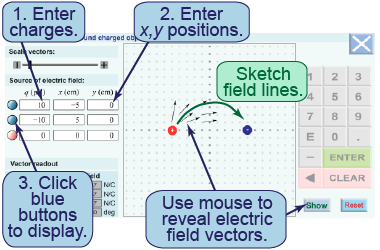|
| Essential questions | | How does the electric force change with distance from a charged object?
How does a force field indicate the electric forces acting on an object? | |
|
Charged particles exert electric forces on each other. These forces are described by Coulomb’s law. The strength and direction of the electric force on a test charge at any point in space is described by the electric field. This interactive simulation draws a vector diagram of the electric field as you change the electric charges that create it. 
|
Part 1: Electric force and Coulomb’s law

- Place a q = +10 μC charge at the position x = 0 cm and y = 0 cm. Press the red button next to it; the button will turn green when it displays the charged object.
- Pass the mouse over the plotting window to reveal the electric field vectors.
- Measure the electric field at positions of 1, 2, 3, 4, and 5 cm away from the charged object.
- Graph the electric field strength against distance away from the charged object.
- By what factor does the electric field change when you double the distance from the object? How about when you triple it?
- What does the shape of your graph tell you about how the electric force varies with distance? Test your conclusion by creating a new, linear graph based on the same data.
- What is the electric field of a neutral object? Enter an object with charge q = 0 μC and compare the field with your prediction.

|
|
In this interactive simulation, you will create one or more electrically charged objects and position them within the display area. Using the mouse, you can investigate the electric field throughout the display area.
|
Part 2: Electric field of multiple charges

- Create a new plot with two charged objects:
- a q = +10 μC charge at position (x, y) = (−5 cm, 0 cm) and
- a q = −10 μC charge at position (x, y) = (+5 cm, 0 cm).
- Select several positions close to the positive charge and follow the arrows as they cross the graph. Sketch the paths in each case.
- How is your sketch related to the forces felt by charged particles?
- How does your sketch compare with a figure somewhere else in this chapter?

|

